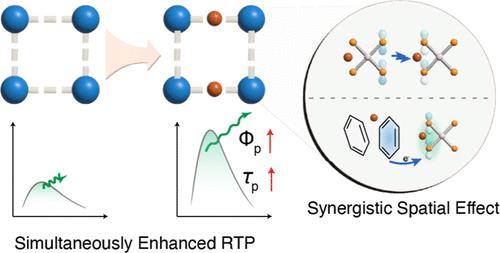Reconfigured Spin-Flip Process Enables Efficient and Persistent Triplet Excitons in Organic–Inorganic Metal Halides
IF 14.4
1区 化学
Q1 CHEMISTRY, MULTIDISCIPLINARY
引用次数: 0
Abstract
Triplet excitons, driven by spin-flip processes, play a crucial role in enabling efficient room-temperature phosphorescence across various applications. However, attaining a significant accumulation of long-lived excitons is impeded by the simultaneous influence of nonradiative and radiative decay pathways alongside intersystem crossing efficiencies. Here, we introduce a solvent intercalation approach that leverages the triplet exciton processes in a family of zero-dimensional organic–inorganic halides, A2ZnBr4 (A = organic phosphonium cations). By intercalating phosphorescence inactive molecules into these halides, their spin-flip processes can be reconfigured. This leads to significantly amplified intersystem crossing but attenuated radiative and nonradiative transitions, which give rise to 16- and 6-fold increases in lifetime and quantum yield, respectively. Our single crystal X-ray diffraction, transient absorption, and theoretical calculation results reveal that such dramatic improvement is attributed to the unique spatial effect on both electrons and holes induced by the intercalated molecules. The consequently reduced orbital degeneracy increases the number of spin-allowed channels, promoting intersystem crossing, while the synergistically enhanced electron localization diminishes the triplet exciton decay, leading to high efficiency and enduring phosphorescence. Our findings offer a new pathway for manipulating the spin-flip process to boost the emission of triplet excitons, with potential applications in designing a wide spectrum of phosphorescent materials.

求助全文
约1分钟内获得全文
求助全文
来源期刊
CiteScore
24.40
自引率
6.00%
发文量
2398
审稿时长
1.6 months
期刊介绍:
The flagship journal of the American Chemical Society, known as the Journal of the American Chemical Society (JACS), has been a prestigious publication since its establishment in 1879. It holds a preeminent position in the field of chemistry and related interdisciplinary sciences. JACS is committed to disseminating cutting-edge research papers, covering a wide range of topics, and encompasses approximately 19,000 pages of Articles, Communications, and Perspectives annually. With a weekly publication frequency, JACS plays a vital role in advancing the field of chemistry by providing essential research.

 求助内容:
求助内容: 应助结果提醒方式:
应助结果提醒方式:


